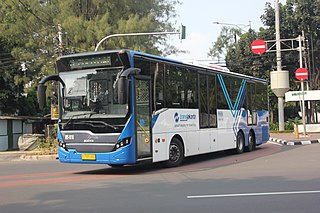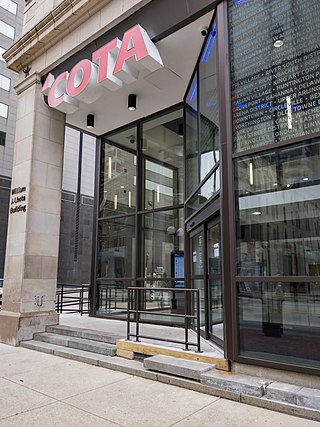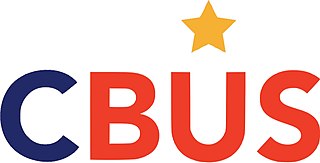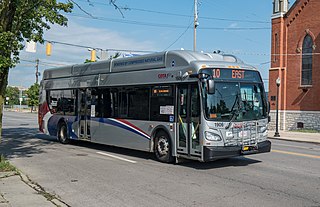
Bus rapid transit (BRT), also referred to as a busway or transitway, is a bus-based public transport system designed to have much more capacity, reliability and other quality features than a conventional bus system. Typically, a BRT system includes roadways that are dedicated to buses, and gives priority to buses at intersections where buses may interact with other traffic; alongside design features to reduce delays caused by passengers boarding or leaving buses, or paying fares. BRT aims to combine the capacity and speed of a light rail transit (LRT) or mass rapid transit (MRT) system with the flexibility, lower cost and simplicity of a bus system.

The Greater Cleveland Regional Transit Authority is the public transit agency for Cleveland, Ohio, United States and the surrounding suburbs of Cuyahoga County. RTA is the largest transit agency in Ohio, with a ridership of 19,104,900, or about 70,900 per weekday as of the third quarter of 2023.

The Interurban Transit Partnership, branded as The Rapid, is the public transit operator serving Grand Rapids, Michigan and its suburbs. In 2022, the system had a ridership of 5,106,600, or about 19,800 per weekday.

The Emerald Express (EmX) is a bus rapid transit (BRT) system in the Eugene-Springfield metropolitan area in Oregon, United States. It is provided by the Lane Transit District (LTD) which is the public transit authority in Lane County, Oregon.

The Central Ohio Transit Authority is a public transit agency serving the Columbus metropolitan area, headquartered in Columbus, Ohio. It operates fixed-route buses, bus rapid transit, microtransit, and paratransit services.

The Metro Red Line is a bus rapid transit line between the Twin Cities suburbs of Bloomington, Minnesota and Apple Valley, Minnesota. The Red Line travels primarily on Minnesota State Highway 77 and Cedar Avenue from the Apple Valley station in Apple Valley, north through Eagan, Minnesota, to the Mall of America station in Bloomington where it connects to the Metro Blue Line. The line has bus rapid transit elements including bus-only lanes, specially branded vehicles, transit signal priority, and dedicated stations.

The Martin Luther King Jr. East Busway is a two-lane bus-only highway serving the city of Pittsburgh and many of its eastern neighborhoods and suburbs. It was named after Martin Luther King Jr. in recognition of the eastern portion of the route's serving many predominantly African-American neighborhoods, such as Wilkinsburg and East Liberty. It is owned and maintained by Pittsburgh Regional Transit.

CTfastrak is a regional bus rapid transit system currently operating between downtown Hartford and Downtown New Britain station in New Britain in central Connecticut. Operated by Connecticut Transit, it is the first bus rapid transit system in Connecticut and the second in New England after the MBTA Silver Line. CTfastrak opened on March 28, 2015 after fifteen years of planning and three years of construction.

The HealthLine is a bus rapid transit (BRT) line run by the Greater Cleveland Regional Transit Authority in Cleveland and East Cleveland, Ohio, United States. The line runs along Euclid Avenue from Public Square in downtown Cleveland to the Louis Stokes Station at Windermere in East Cleveland. It began operation on October 24, 2008. Its current name was the result of a naming rights deal with the Cleveland Clinic and University Hospitals of Cleveland. The HealthLine is denoted with a silver color and abbreviated simply as HL on most RTA publications.

The South Busway is a two-lane bus rapid transit highway serving southern portions of the city of Pittsburgh. The busway runs for 4.3 miles (6.9 km) from the Mt. Washington Transit Tunnel across the Monongahela River from Downtown Pittsburgh to the Overbrook neighborhood of the city, bypassing the crowded Pennsylvania Route 51. It is owned and maintained by Pittsburgh Regional Transit, the public transit provider for Allegheny County and the Pittsburgh region.

Metro Busway is a system of bus rapid transit (BRT) routes that operate primarily along exclusive or semi-exclusive roadways known locally as a busway or transitway. There are currently two lines serving 29 stations in the system, the G Line in the San Fernando Valley, and the J Line between El Monte, Downtown Los Angeles and Gardena, with some trips continuing to San Pedro. The Los Angeles County Metropolitan Transportation Authority (Metro) operates the system.

Bus rapid transit creep is a phenomenon commonly defined as a bus rapid transit (BRT) system that fails to meet the requirements to be considered "true BRT". These systems are often marketed as a fully realized bus rapid transit system, but end up being described as more of an improvement to regular bus service by proponents of the "BRT creep" term. The Institute for Transportation and Development Policy published several guidelines in an attempt to define what constitutes the term of "true BRT", known as the BRT Standard, in an attempt to avert this phenomenon.

The Metrobus network provides bus service throughout Miami-Dade County 365 days a year, operated by Miami-Dade Transit. It consists of about 93 routes and 893 buses, which connect most points in the county and part of southern Broward County as well. As of 2022, the system has 41,854,200 rides per year, or about 175,600 per day in the third quarter of 2023.

Public transit has taken numerous forms in Columbus, the largest city and capital of Ohio. Transit has variously used passenger trains, horsecars, streetcars, interurbans, trolley coaches, and buses. Current service is through the Central Ohio Transit Authority's bus system, numerous intercity bus companies, and through bikeshare, rideshare, and electric scooter services.

The CBUS was a free downtown circulator bus in Columbus, Ohio. The service was operated by the Central Ohio Transit Authority. The CBUS service primarily traveled along High Street between the Brewery District and the Short North. The service had uniquely-branded 30-foot buses stopping at round "CBUS" signs. The service operated every 10–15 minutes, seven days per week. The service began operation on May 5, 2014.

The 10 E Broad / W Broad is a Central Ohio Transit Authority (COTA) bus service in Columbus, Ohio. The line operates on Broad Street, the city's main east-west thoroughfare.

The 2 E Main / N High is a Central Ohio Transit Authority (COTA) bus service in Columbus, Ohio. The line operates on High Street, the city's main north-south thoroughfare.





















